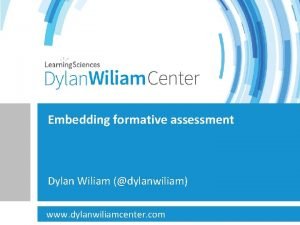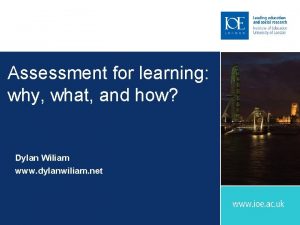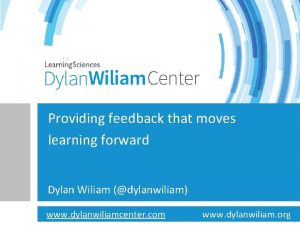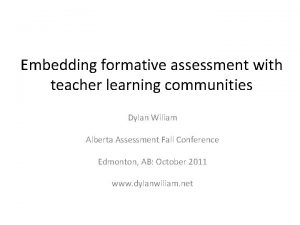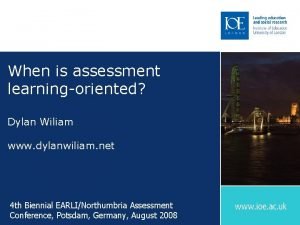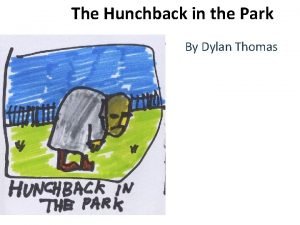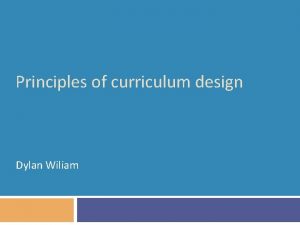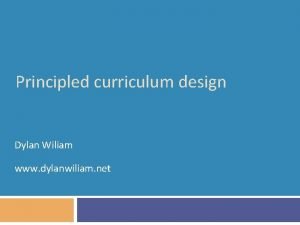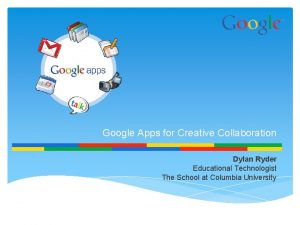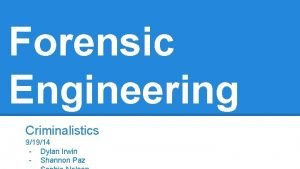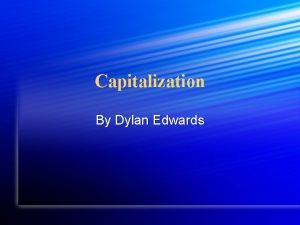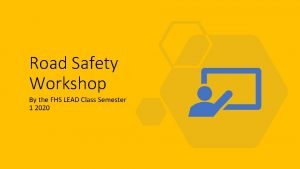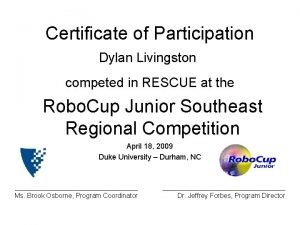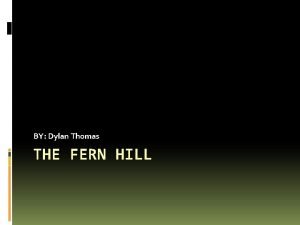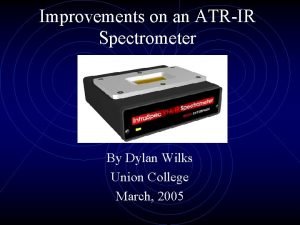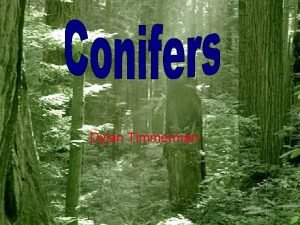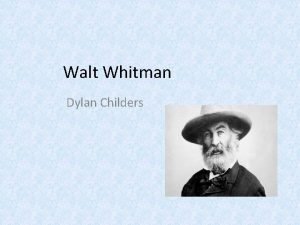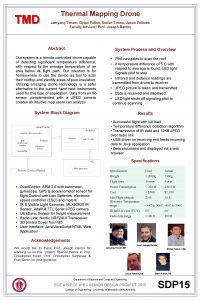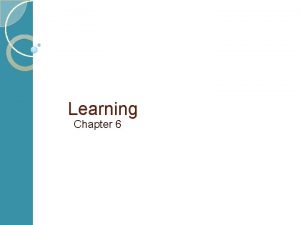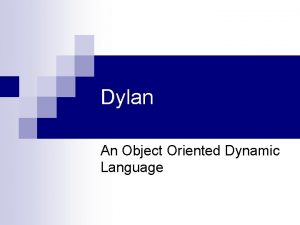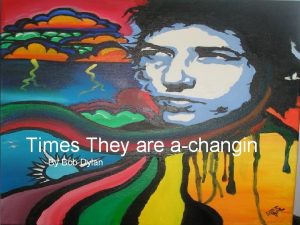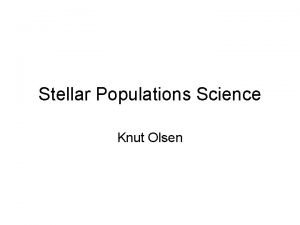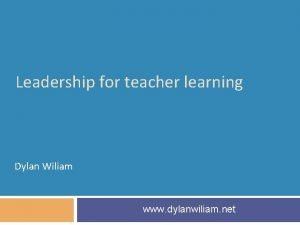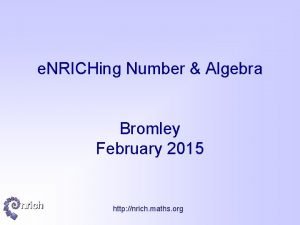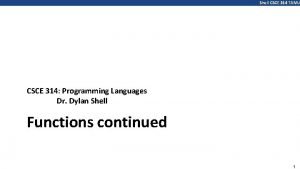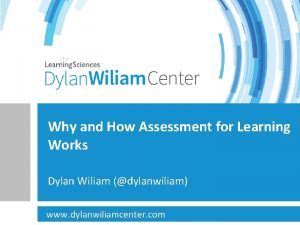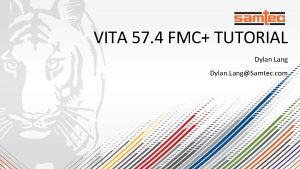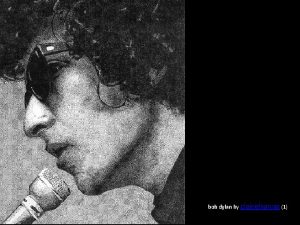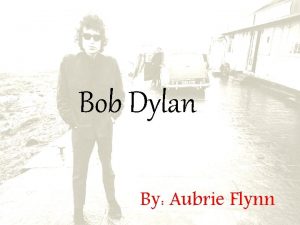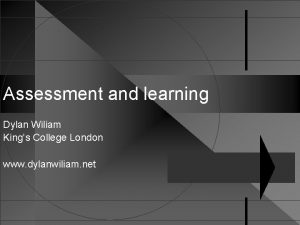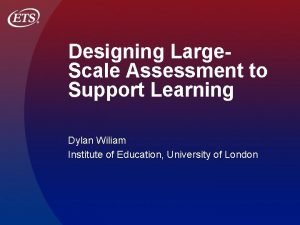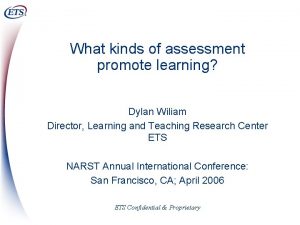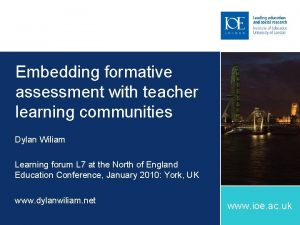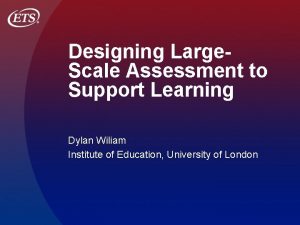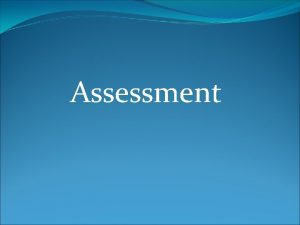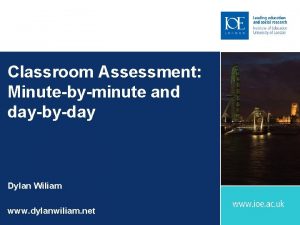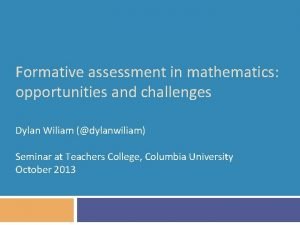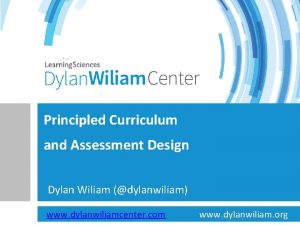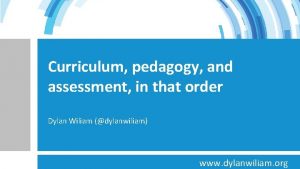Assessment for learning why what and how Dylan





































- Slides: 37

Assessment for learning: why, what, and how? Dylan Wiliam

Overview of presentation Why raising achievement is important Why investing in teachers is the answer Why formative assessment should be the focus Why teacher learning communities should be the mechanism How we can put this into practice Why, what & how?

Raising achievement matters For individuals Increased lifetime salary Improved health Longer life For society Lower criminal justice costs Lower health-care costs Increased economic growth Why?

Where’s the solution? Structure Smaller high schools Larger high schools K-8 schools Alignment Curriculum reform Textbook replacement Governance Charter schools Vouchers Technology Computers Interactive white-boards Why?

School effectiveness Three generations of school effectiveness research Raw results approaches Different schools get different results Conclusion: Schools make a difference Demographic-based approaches Demographic factors account for most of the variation Conclusion: Schools don’t make a difference Value-added approaches School-level differences in value-added are relatively small Classroom-level differences in value-added are large Conclusion: An effective school is a school full of effective classrooms Why?

It’s the classroom Variability at the classroom level is up to 4 times that at school level It’s not class size It’s not the between-class grouping strategy It’s not the within-class grouping strategy It’s the teacher Why?

Teacher quality A labour force issue with 2 solutions Replace existing teachers with better ones? No evidence that more pay brings in better teachers No evidence that there are better teachers out there deterred by burdensome certification requirements Improve the effectiveness of existing teachers The “love the one you’re with” strategy It can be done We know how to do it, but at scale? Quickly? Sustainably? Why?

Cost/effect comparisons Intervention Extra months of learning per year Cost/yr Class-size reduction (by 30%) 4 £ 20 k Increase teacher content knowledge from weak to strong 2 ? Formative assessment/ Assessment for learning 8 £ 2 k Why?

The research evidence Several major reviews of the research Natriello (1987) Crooks (1988) Kluger & De. Nisi (1996) Black & Wiliam (1998) Nyquist (2003) All find consistent, substantial effects Why?

Formative assessment Assessment for learning is any assessment for which the first priority in its design and practice is to serve the purpose of promoting pupils’ learning. It thus differs from assessment designed primarily to serve the purposes of accountability, or of ranking, or of certifying competence. An assessment activity can help learning if it provides information to be used as feedback, by teachers, and by their pupils, in assessing themselves and each other, to modify the teaching and learning activities in which they are engaged. Such assessment becomes ‘formative assessment’ when the evidence is actually used to adapt the teaching work to meet learning needs. Black, Harrison, Lee, Marshall & Wiliam, 2002

Types of formative assessment Long-cycle Span: across units, terms Length: four weeks to one year Impact: Student monitoring; curriculum alignment Medium-cycle Span: within and between teaching units Length: one to four weeks Impact: Improved, student-involved, assessment; teacher cognition about learning Short-cycle Span: within and between lessons Length: day-by-day: 24 to 48 hours minute-by-minute: 5 seconds to 2 hours Impact: classroom practice; student engagement What?

Unpacking formative assessment Key processes Establishing where the learners are in their learning Establishing where they are going Working out how to get there Participants Teachers Peers Learners What?

Aspects of formative assessment Teacher Peer Learner Where the learner is going Where the learner is How to get there Clarify and share learning intentions Engineering effective discussions, tasks and activities that elicit evidence of learning Providing feedback that moves learners forward Understand share learning intentions Activating students as learning resources for one another Understand learning intentions Activating students as owners of their own learning

Five “key strategies”… Clarifying, understanding, and sharing learning intentions curriculum philosophy Engineering effective classroom discussions, tasks and activities that elicit evidence of learning classroom discourse, interactive whole-class teaching Providing feedback that moves learners forward feedback Activating students as learning resources for one another collaborative learning, reciprocal teaching, peer-assessment Activating students as owners of their own learning metacognition, motivation, interest, attribution, self-assessment (Wiliam & Thompson, 2007)

…and one big idea Use evidence about learning to adapt teaching and learning to meet student needs What?

Keeping Learning on Track (KLT) A pilot guides a plane or boat toward its destination by taking constant readings and making careful adjustments in response to wind, currents, weather, etc. A KLT teacher does the same: Plans a carefully chosen route ahead of time (in essence building the track) Takes readings along the way Changes course as conditions dictate What?

Putting it into practice

Why research hasn’t changed teaching The nature of expertise in teaching Aristotle’s main intellectual virtues Episteme: knowledge of universal truths Techne: ability to make things Phronesis: practical wisdom What works is not the right question Everything works somewhere Nothing works everywhere What’s interesting is “under what conditions” does this work? Teaching is mainly a matter of phronesis, not episteme How?

Knowledge ‘transfer’ After Nonaka & Tageuchi, 1995 How?

Implementing FA/Af. L requires changing teacher habits Teachers “know” most of this already So the problem is not a lack of knowledge It’s a lack of understanding what it means to do FA/Af. L That’s why telling teachers what to do doesn’t work Experience alone is not enough—if it were, then the most experienced teachers would be the best teachers—we know that’s not true (Hanushek, 2005; Day, 2006) People need to reflect on their experiences in systematic ways that build their accessible knowledge base, learn from mistakes, etc. (Bransford, Brown & Cocking, 1999) How?

A model for teacher learning Content, then process Content (what we want teachers to change) Evidence Ideas (strategies and techniques) Process (how to go about change) Choice Flexibility Small steps Accountability Support How?

Strategies and techniques Distinction between strategies and techniques Strategies define the territory of Af. L (no brainers) Teachers are responsible for choice of techniques Allows for customization/ caters for local context Creates ownership Shares responsibility Key requirements of techniques embodiment of deep cognitive/affective principles relevance feasibility acceptability How?

Examples of techniques Learning intentions “sharing exemplars” Eliciting evidence “mini white-boards” Providing feedback “find it and fix it” Students as owners of their learning “coloured cups” Students as learning resources “pre-flight checklist” How?

Design and intervention Our design process cognitive/affective insights synergy/ comprehensiveness set of components Teachers’ implementation process set of components synergy/ comprehensiveness cognitive/affective insights

Teacher learning takes time To put new knowledge to work, to make it meaningful and accessible when you need it, requires practice. A teacher doesn’t come at this as a blank slate. Not only do teachers have their current habits and ways of teaching— they’ve lived inside the old culture of classrooms all their lives: every teacher started out as a student! New knowledge doesn’t just have to get learned and practiced, it has to go up against long-established, familiar, comfortable ways of doing things that may not be as effective, but fit within everyone’s expectations of how a classroom should work. It takes time and practice to undo old habits and become graceful at new ones. Thus… Professional development must be sustained over time How?

That’s what teacher learning communities (TLCs) are for: TLCs contradict teacher isolation TLCs reprofessionalize teaching by valuing teacher expertise TLCs deprivatize teaching so that teachers’ strengths and struggles become known TLCs offer a steady source of support for struggling teachers They grow expertise by providing a regular space, time, and structure for that kind of systematic reflecting on practice They facilitate sharing of untapped expertise residing in individual teachers They build the collective knowledge base in a school How?

King’s-Medway-Oxfordshire Formative Assessment Project “Polyexperiment” design 24 teachers, each developing their practice in individual ways Each teacher chose which class to explore these ideas with Each teacher chose how to measure success Different outcome variables, so no possibility of standardized controls Synthesis by standardized effect size Impact on student achievement 0. 3 standard deviations (i. e. , about 8 months extra learning per year) Other small-scale replications (Hayes, 2003; Clymer 2007) find similar effects How?

Taking it to scale

Designing for scale “In-principle” scalability A single model for the whole school But which honours subject-specificities Understanding what it means to scale (Coburn, 2003) Depth Sustainability Spread Shift in reform ownership Consideration of the diversity of contexts of application Clarity about components, and theory of action How?

Logic model for KLT (Leahy, Leusner & Lyon, 2005)

How to set up a TLC Plan that the TLC will run for two years Identify 8 to 10 interested colleagues Should have similar assignments (e. g. early years, math/sci) Secure institutional support for: Monthly meetings (2 hrs each, inside or outside school time) Time between meetings (2 hrs per month in school time) Collaborative planning Peer observation Any necessary waivers from school policies How?

A ‘signature pedagogy’ for teacher learning? Every monthly TLC meeting should follows the same structure and sequence of activities Activity 1: Introduction & Housekeeping (5 minutes) Activity 2: How’s It Going (50 minutes) Activity 3: New Learning about Af. L (50 minutes) Activity 4: Personal Action Planning (10 minutes) Activity 5: Summary of Learning (5 minutes) How?

The TLC leader’s role To ensure the TLC meets regularly To ensure all needed materials are at meetings To ensure that each meeting is focused on Af. L To create and maintain a productive and non-judgmental tone during meetings To ensure that every participant shares with regard to their implementation of Af. L To encourage teachers to provide their colleagues with constructive and thoughtful feedback To encourage teachers to think about and discuss the implementation of new Af. L learning and skills To ensure that every teacher has an action plan to guide their next steps But not to be the Af. L “expert” How?

Peer observation Run to the agenda of the observed, not the observer Observed teacher specifies focus of observation Observe teacher specifies what counts as evidence e. g. , teacher wants to increase wait-time provides observer with a stop-watch to log wait-times How?

“Tight but loose” Some reforms are too loose (e. g. , the ‘Effective schools’ movement) Others are too tight (e. g. , Montessori Schools) The “tight but loose” formulation … combines an obsessive adherence to central design principles (the “tight” part) with accommodations to the needs, resources, constraints, and particularities that occur in any school or district (the “loose” part), but only where these do not conflict with theory of action of the intervention. Tight about Teacher choice Strategies “How’s it going? ” & action planning Size of TLC Loose about Timing and location of meetings Techniques New learning about Af. L Make-up of TLC How?

Implementations Successful pilots in: Cleveland Municipal School District, OH Austin Independent School District, TX Chico Unified School District, CA Mathematics and Science Partnership of Greater Philadelphia, PA/NJ St. Mary’s County Public Schools, MD State-wide pilot in 10 schools in Vermont Impact on student achievement similar to KMOFAP

Summary Raising achievement is important Raising achievement requires improving teacher quality Improving teacher quality requires teacher professional development To be effective, teacher professional development must address What teachers do in the classroom How teachers change what they do in the classroom Af. L/FA + TLCs A point of (uniquely? ) high leverage A “Trojan Horse” into wider issues of pedagogy, psychology, and curriculum Why, what & how?
 Hey bye bye
Hey bye bye What is the aera
What is the aera Dylan wiliam formative assessment
Dylan wiliam formative assessment Providing feedback that moves learning forward
Providing feedback that moves learning forward Dylan wiliam teacher learning communities
Dylan wiliam teacher learning communities What is assessment
What is assessment Cuadro comparativo de e-learning
Cuadro comparativo de e-learning Dont ask
Dont ask Dylan thomas the hunchback in the park
Dylan thomas the hunchback in the park Dylan wiliam curriculum design
Dylan wiliam curriculum design Principled curriculum design
Principled curriculum design Dylan ryder wife
Dylan ryder wife Forensic engineer jobs
Forensic engineer jobs Dylan o brien freundin
Dylan o brien freundin Dylan edwards on3
Dylan edwards on3 The hunchback in the park
The hunchback in the park Dylan friedmann
Dylan friedmann Dylan briggs accident frankston
Dylan briggs accident frankston Gdworkshop
Gdworkshop Dylan livingston
Dylan livingston Dylan thomas bio
Dylan thomas bio Dylan terpstra
Dylan terpstra Dylan wilks
Dylan wilks Dylan timmerman
Dylan timmerman Dylan thomas bio
Dylan thomas bio Dylan horrocks hicksville
Dylan horrocks hicksville Dylan childers
Dylan childers Dylan fallon
Dylan fallon Bob dylan
Bob dylan Dylan's mother buys him a sailor's cap
Dylan's mother buys him a sailor's cap Dylan programming language
Dylan programming language Bob dylan the times they are a-changin' lyrics
Bob dylan the times they are a-changin' lyrics Dylan knut olsen bokvist
Dylan knut olsen bokvist Tlc dylan wiliam
Tlc dylan wiliam Bob dylan dark side of the road
Bob dylan dark side of the road Nrich lemonade
Nrich lemonade Csce 314 tamu
Csce 314 tamu Costless collar oil
Costless collar oil

